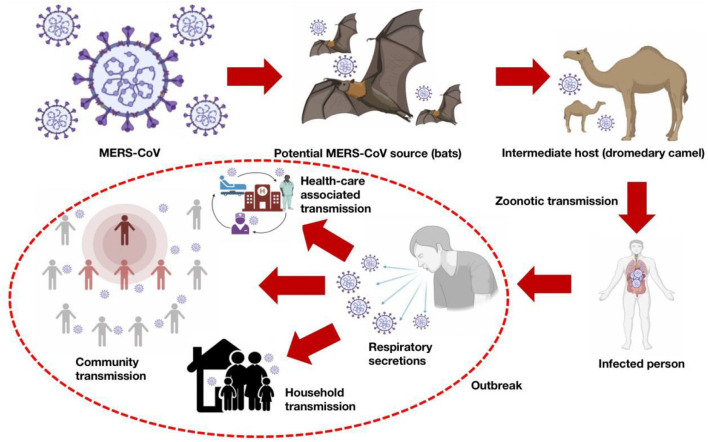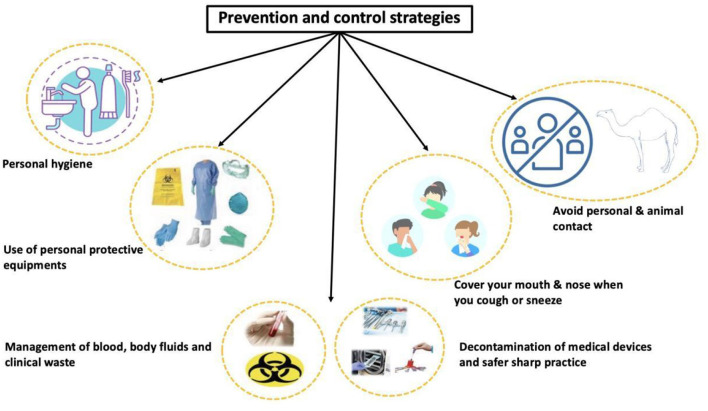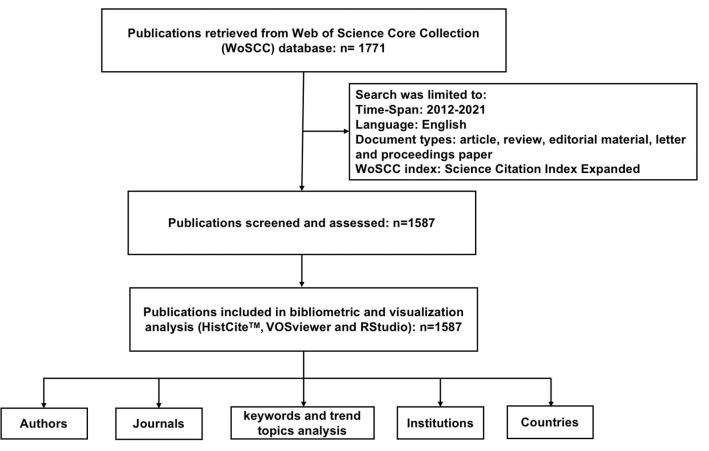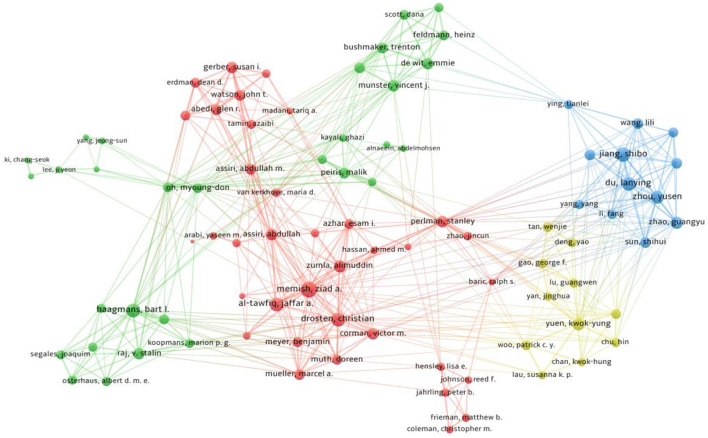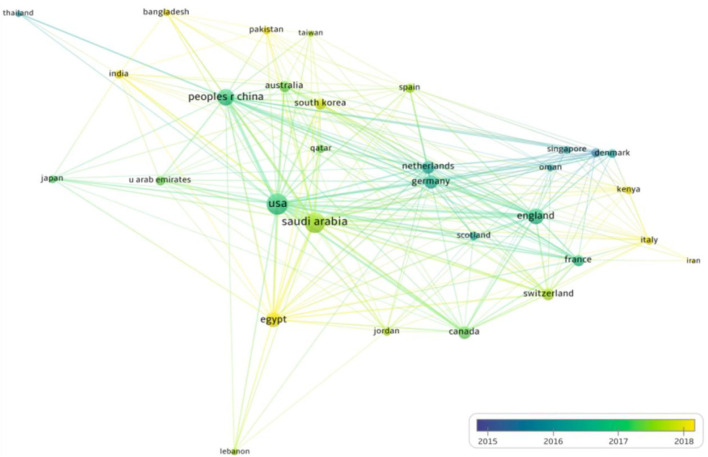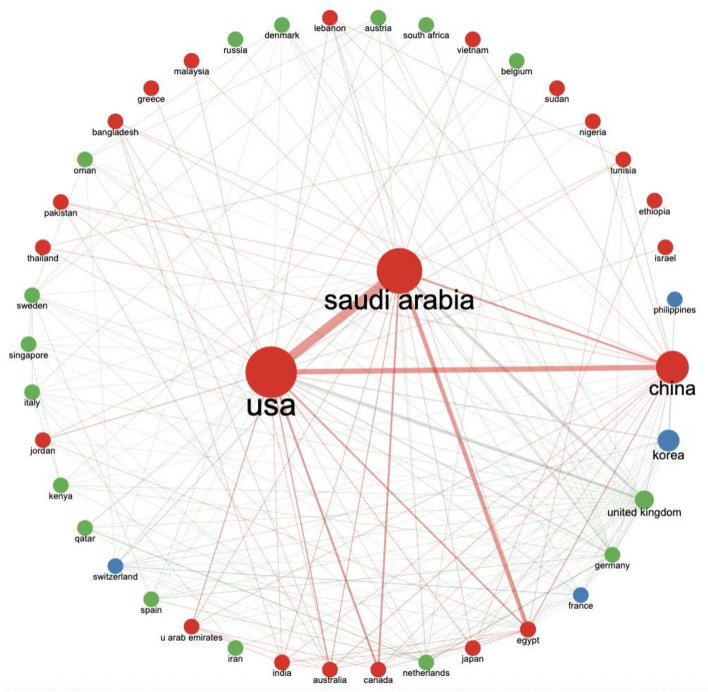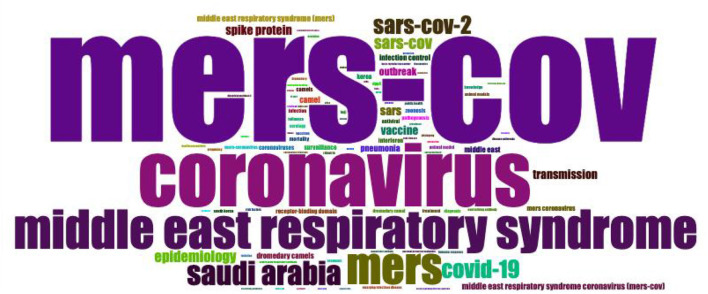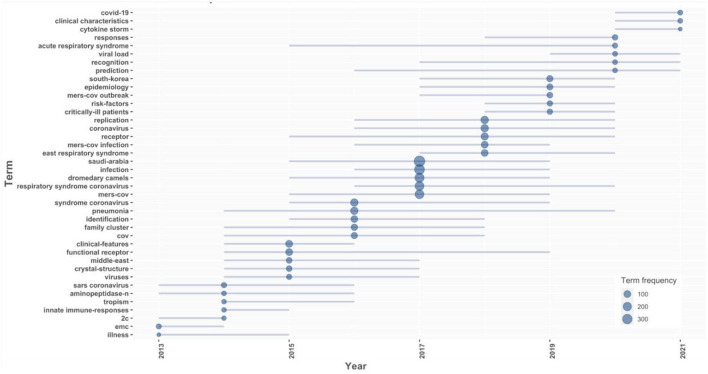Abstract
Background
The Middle East respiratory syndrome coronavirus (MERS-CoV) was first reported in Saudi Arabia in 2012. So far, the cases of MERS-CoV have been reported in 27 countries. The virus causes severe health complications, resulting high mortality.
Aim
The current study aimed to evaluate the global research trends and key bibliometric indices in MERS-CoV research from 2012 to 2021.
Methods
A retrospective bibliometric and visualized study was conducted. The Science Citation Index Expanded Edition of Web of Science Core Collection database was utilized to retrieve published scientific literature on MERS-CoV. The retrieved publications were assessed for a number of bibliometric attributes. The data were imported into HistCiteTM and VOSviewer software to calculate the citations count and perform the visualization mapping, respectively. In addition, countries or regions collaboration, keywords analysis, and trend topics in MERS-CoV were assessed using the Bibliometrix: An R-tool.
Results
A total of 1,587 publications, published in 499 journals, authored by 6,506 authors from 88 countries or regions were included in the final analysis. Majority of these publications were published as research article (n = 1,143). Globally, these publications received 70,143 citations. The most frequent year of publication was 2016 (n = 253), while the most cited year was 2014 (11,517 citations). The most prolific author was Memish ZA (n = 94), while the most published journal was Emerging Infectious Diseases (n = 80). The United States of America (USA) (n = 520) and Saudi Arabia (n = 432) were the most influential and largest contributors to the MERS-CoV publications. The extensively studied research area was infectious diseases. The most frequently used author keywords other than search keywords were Saudi Arabia, SARS-CoV-2, COVID-19, epidemiology, transmission, spike protein, vaccine, outbreak, camel, and pneumonia.
Conclusion
This study provides an insight into MERS-CoV-related research for scientific community (researchers, academicians) to understand and expand the basic knowledge structure, potential collaborations, and research trend topics. This study can also be useful for policy makers. After the emergence of MERS-CoV, a significant increase in scientific production was observed in the next 4 years (2013–2016). In 2021, the trend topics in MERS-CoV-related research were COVID-19, clinical characteristics, and cytokine storm. Saudi Arabia had the strongest collaboration with the USA, while the USA had the highest collaboration with China.
Keywords: MERS-CoV, bibliometric analysis, HistCiteTM, VOSviewer software, WoSCC database, COVID-19
Introduction
The first case of Middle East respiratory syndrome coronavirus (MERS-CoV) was reported from Saudi Arabia in 2012 (1). A 60-year-old man was admitted to a private hospital in Jeddah on June 13, 2012, with 1-week history of cough, expectoration, fever, and shortness of breath. On June 14, 2012, the patient died due to a rapidly deteriorating clinical course (1–3). After 3 months, a new β coronavirus previously known as human coronavirus Erasmus Medical Center virus was detected (4). Later on, the “Coronavirus Study Group of the International Committee on Taxonomy of Viruses” renamed the virus as MERS-CoV (5).
Globally, a total of 2,574 laboratory confirmed cases, along with 886 deaths, have been reported to World Health Organization (WHO) as of March 11, 2021 (6). In addition, between January 1, 2021 and December 6, 2021, 14 laboratory confirmed cases of MERS-CoV were reported in Saudi Arabia (n = 13), and the United Arab Emirates (n = 1), including five deaths (7). So far, the MERS-CoV cases have been reported in 27 countries (7).
Most importantly, infection with MERS-CoV can cause severe health complications, resulting in high mortality, specifically in patients with chronic lung diseases, diabetes, immunocompromised persons, and renal failure (6). MERS-CoV is zoonotic in nature, and bats are considered to be a potential reservoir, while a dromedary camel is an intermediate host. Sporadically, MERS-CoV is transmitted from a dromedary camel to humans, and, occasionally, via human-to-human contact (8–11). The potential routes of MERS-CoV emergence and transmission are presented in Figure 1. It is necessary to prevent or reduce zoonotic spillover events since 60–75% of human infectious diseases emerged from pathogens originally circulating in non-human animal species (12).
Figure 1.
Potential routes of emergence and transmission of MERS-CoV.
In the light of available scientific literature, MERS-CoV possesses significant public health challenges (6). Moreover, good personal hygiene and medical practices should be followed to prevent the spread of MERS-CoV as shown in Figure 2.
Figure 2.
Prevention and control strategies for MERS-CoV.
Till to date, a number of bibliometric studies have been published on MERS-CoV (13–16).
Bibliometric methods are frequently used for quantitative and qualitative scholarly publications analyses and changes in research activity over time in a particular field or subject (17–19). Bibliometric analysis could be used as an objective criterion to assess and evaluate the research production by scientists, institutes, and countries (19, 20). Importantly, bibliometric analysis serves as a referral point of contact for policy makers and researchers, as well as a guide for future research direction (21). Therefore, the use of these methods has significantly increased over the last decade in medical and health sciences disciplines. However, there is no comprehensive updated bibliometric and visualization study available. Thus, the current study was conducted to determine the global research trends, achievements, and keystone bibliometric indices in MERS-CoV research during the past 10 years.
Methods
Study design
A retrospective bibliometric and visualized study was conducted.
Data source and search operations
On January 1, 2022, the Science Citation Index Expanded (SCI-Expanded) Edition of Web of Science Core Collection (WoSCC) database was searched for the relevant scientific literature on MERS-CoV. The following searching keywords were utilized in the title field, applying the Boolean search method: “Middle East respiratory syndrome” or “Middle East respiratory syndrome coronavirus” or “MERS-CoV” or “human coronavirus Erasmus Medical Center virus” or “novel coronavirus.” The search was limited to publishing language (English), document types (article, review, editorial material, letter, and proceedings paper), and publications year (2012–2021). However, the search with a keyword “novel coronavirus” was limited from 2012 to 2019 to avoid the scientific publications on the recently emerged coronavirus (SARS-CoV-2). A total of 41 publications were retrieved with a keyword “novel coronavirus,” while the other keywords retrieved a total of 1,730 publications. After screening the titles and abstracts of all the publications on MERS-CoV, a total of 1,587 publications were included in the final analysis as shown in Figure 3. The data were downloaded both in comma-separated values and plain-text format.
Figure 3.
A publications selection flow chart included in the final analysis.
Data extraction
A number of attributes were extracted, including publication title, year of publication, authors name, journals name, keywords, institution, country of origin, and citations count. The impact factor (IF) of the journals was obtained from the Incites Journal Citation Reports 2020, released by Clarivate Analytics on June 30, 2021.
Data analysis
The obtained data were exported into HistCiteTM software, version 12.3.17; VOSviewer software, version 1.6.17; and Bibliometrix: An R-tool, version 3.2.1 to perform the prerequisite analysis. The citations count was calculated using HistCiteTM software (22). Both the local citations score (LCS) and the global citations score (GCS) were calculated. LCS means how many times a paper has been cited by other papers included in the sample (documents or publications analyzed in the current study), while GCS means a paper has been cited by all the included papers in the WoSCC database (23).
Furthermore, the obtained data were plotted for co-authorship authors' network visualization and co-authorship countries or regions overlay visualization mapping using VOSviewer software (24). In addition, the data were imported into RStudio (Bibliometrix package) to analyze inter-countries or regions collaboration, keywords analysis, and trend topics in MERS-CoV research over the years. The calculated values were presented in number/frequency (n) and percentage (%).
Ethics statement
In the current study, no animal or human subjects were recruited directly. Therefore, no ethical consideration was required.
Results
In this study, a total of 1,587 documents or publications were included in the final analysis. These documents were published in 499 journals, authored by 6,506 authors (4.1 authors per document, 7.92 co-authors per document) from 88 countries. The authors collaboration index was recorded 4.36, as shown in Table 1.
Table 1.
Main information about the included and analyzed publications on MERS-CoV between 2012 and 2021.
| Description | Results |
|---|---|
| Main information | |
| Time-Span | 2012–2021 |
| Journals | 499 |
| Documents or publications | 1,587 |
| Institutions (affiliations) | 1,627 |
| Countries or regions | 88 |
| Average years from publication | 4.89 |
| Average citations per document | 44.2 |
| Average citations per year per document | 7.134 |
| Local citations score | 14,139 |
| Global citations score | 70,143 |
| References | 22,459 |
| Document types | |
| Research article | 1,143 |
| Review | 183 |
| Editorial material | 130 |
| Letter | 108 |
| Proceedings paper | 23 |
| Document contents | |
| KeyWords Plus | 1,660 |
| Author's keywords | 2,062 |
| Authors | |
| Authors | 6,506 |
| Author appearances | 12,572 |
| Authors of single-authored documents | 90 |
| Authors of multi-authored documents | 6,416 |
| Authors collaboration | |
| Single-Authored documents | 117 |
| Documents per author | 0.244 |
| Authors per document | 4.1 |
| Co-Authors per document | 7.92 |
| Collaboration index | 4.36 |
Most cited publications and frequent years
The included publications received a total of 14,139 LCS and 70,143 GCS (Table 1). The most cited publication was “Isolation of a Novel Coronavirus from a Man with Pneumonia in Saudi Arabia,” published in New England Journal of Medicine in 2012, received 2,994 citations (272.18 citations per year) as shown in Table 2. The most frequent years of publication were 2016 (n = 253), and 2015 (n = 206), while the most cited years were 2014 (11,517 citations), and 2013 (11,173 citations), as presented in Table 3.
Table 2.
Top 10 most-cited publications on MERS-CoV according to GCS at the time of search.
| Ranking | Publication title | LCS | LCS per year | GCS | GCS per year | References |
|---|---|---|---|---|---|---|
| 1 | Isolation of a Novel Coronavirus from a Man with Pneumonia in Saudi Arabia | 783 | 71.18 | 2,994 | 272.18 | (1) |
| 2 | Comparative therapeutic efficacy of remdesivir and combination lopinavir, ritonavir, and interferon beta against MERS-CoV | 0 | 0.00 | 873 | 291.00 | (25) |
| 3 | Epidemiological, demographic, and clinical characteristics of 47 cases of Middle East respiratory syndrome coronavirus disease from Saudi Arabia: a descriptive study | 295 | 29.50 | 841 | 84.10 | (26) |
| 4 | Hospital outbreak of Middle East respiratory syndrome coronavirus | 418 | 41.80 | 787 | 78.70 | (27) |
| 5 | Middle East Respiratory Syndrome Coronavirus (MERS-CoV): Announcement of the Coronavirus Study Group | 0 | 0.00 | 676 | 67.60 | (5) |
| 6 | Corticosteroid therapy for critically ill patients with Middle East respiratory syndrome | 18 | 3.60 | 616 | 123.20 | (28) |
| 7 | Middle East respiratory syndrome | 176 | 22.00 | 589 | 73.63 | (29) |
| 8 | Middle East respiratory syndrome coronavirus: another zoonotic betacoronavirus causing SARS-like disease | 87 | 10.88 | 481 | 60.13 | (30) |
| 9 | Middle East respiratory syndrome coronavirus neutralizing serum antibodies in dromedary camels: a comparative serological study | 233 | 23.30 | 467 | 46.70 | (31) |
| 10 | Prophylactic and therapeutic remdesivir (GS-5734) treatment in the rhesus macaque model of MERS-CoV infection | 0 | 0.00 | 437 | 145.67 | (32) |
Table 3.
Year of publications.
| Publications year | Number of published papers | Percentage | LCS | GCS |
|---|---|---|---|---|
| 2012 | 8 | 0.5 | 823 | 3,411 |
| 2013 | 100 | 6.3 | 3,700 | 11,173 |
| 2014 | 153 | 9.6 | 3,116 | 11,517 |
| 2015 | 206 | 13.0 | 2,622 | 9,513 |
| 2016 | 253 | 15.9 | 2,022 | 10,380 |
| 2017 | 182 | 11.5 | 847 | 6,582 |
| 2018 | 151 | 9.5 | 541 | 5,734 |
| 2019 | 177 | 11.2 | 313 | 4,556 |
| 2020 | 190 | 12.0 | 135 | 6,474 |
| 2021 | 167 | 10.6 | 20 | 803 |
Publication types, leading authors, and journals
The publication types were research article (n = 1,143), review (n = 183), editorial material (n = 130), letter (n = 108), and proceedings paper (n = 23), as presented in Table 4. Based on the number of publications, the most active authors were Memish ZA (n = 94), Al-Tawfiq (n = 71), Drosten C (n = 45), Haagmans BL (n = 42), and Gerber SI (n = 38) as shown in Table 5. The Emerging Infectious Diseases was the leading journal (n = 80), followed by Journal of Virology (n = 65), and Journal of Infection and Public Health (n = 44), as shown in Table 6.
Table 4.
Types of publication.
| Publication types | Number of published papers | Percentage | LCS | GCS |
|---|---|---|---|---|
| Research article | 1,143 | 72.0 | 12,373 | 58,065 |
| Review | 183 | 11.5 | 835 | 7,808 |
| Editorial material | 130 | 8.2 | 430 | 1,960 |
| Letter | 108 | 6.8 | 469 | 1,965 |
| Proceedings paper | 23 | 1.4 | 32 | 345 |
Table 5.
Top 10 most prolific authors based on number of publications.
| Ranking | Author | Affiliation | Number of published papers | Percentage | LCS | LCS per year | GCS | GCS per year |
|---|---|---|---|---|---|---|---|---|
| 1 | Ziad A. Memish | Research Center, King Saud Medical City, Ministry of Health, Riyadh, Saudi Arabia | 94 | 5.9 | 2,628 | 303.90 | 8,630 | 1,148.95 |
| 2 | Jaffar A. Al-Tawfiq | Infectious Disease Unit, Specialty Internal Medicine, Johns Hopkins Aramco Healthcare, Dhahran, Saudi Arabia | 71 | 4.5 | 1,453 | 162.94 | 4,861 | 650.46 |
| 3 | Christian Drosten | Institute of Virology, Charité—Universitätsmedizin Berlin, Helmut-Ruska-Haus Charitéplatz 1, 10117 Berlin, Germany | 45 | 2.8 | 1,451 | 166.08 | 4,745 | 567.60 |
| 4 | Bart L. Haagmans | Department of Viroscience, Erasmus Medical Center, Rotterdam, The Netherlands | 42 | 2.6 | 1,109 | 134.34 | 2,985 | 397.60 |
| 5 | Susan I. Gerber | Centers for Disease Control and Prevention, Atlanta, Georgia, USA | 38 | 2.4 | 677 | 95.59 | 1,976 | 299.04 |
| 6 | Shibo Jiang | School of Basic Medical Sciences and Shanghai Public Health Clinical Center, Fudan University, Shanghai 200032, China | 37 | 2.3 | 592 | 72.65 | 2,436 | 331.60 |
| 7 | Stanley Perlman | Department of Microbiology and Immunology, and Department of Pediatrics, University of Iowa, Iowa City, IA, USA | 35 | 2.2 | 586 | 78.76 | 3,315 | 489.17 |
| 8 | *Yaseen M. Arabi | King Saud Bin Abdulaziz University for Health Sciences Riyadh, Saudi Arabia | 33 | 2.1 | 368 | 56.24 | 2,671 | 500.43 |
| 8 | *Jun-Young Lee | Korea Research Institute of Chemical Technology, 141 Gajeong-ro, Yuseong-gu, Daejeon 34114, South Korea | 33 | 2.1 | 255 | 40.48 | 1,024 | 181.61 |
| 9 | Alimuddin Zumla | Division of Infection and Immunity, University College London, London, United Kingdom | 32 | 2.0 | 713 | 92.56 | 2,226 | 346.18 |
| 10 | Malik Peiris | School of Public Health, The University of Hong Kong, No 7 Sassoon Rd, Pokfulam, Hong Kong | 30 | 1.9 | 333 | 49.13 | 984 | 142.85 |
Both the authors produced equal number of papers.
Table 6.
Top 10 most published journals.
| Ranking | Journal | IF 2020 | Number of published papers | Percentage | LCS | LCS per year | GCS | GCS per year | Local cited references |
|---|---|---|---|---|---|---|---|---|---|
| 1 | Emerging Infectious Diseases | 6.883 | 80 | 5.0 | 1,360 | 182.41 | 3,357 | 490.62 | 566 |
| 2 | Journal of Virology | 5.103 | 65 | 4.1 | 1,353 | 150.12 | 5,250 | 665.32 | 547 |
| 3 | Journal of Infection and Public Health | 3.718 | 44 | 2.8 | 121 | 24.00 | 989 | 229.70 | 384 |
| 4 | Eurosurveillance | 6.307 | 40 | 2.5 | 90 | 10.27 | 2,125 | 231.09 | 135 |
| 5 | Viruses-Basel | 5.048 | 37 | 2.3 | 0 | 0.00 | 682 | 158.62 | 659 |
| 6 | International Journal of Infectious Diseases | 3.623 | 33 | 2.1 | 543 | 66.04 | 1,998 | 299.07 | 211 |
| 7 | Plos One | 3.24 | 31 | 2.0 | 0 | 0.00 | 1,062 | 144.26 | 256 |
| 8 | Lancet Infectious Diseases | 25.071 | 27 | 1.7 | 1,293 | 146.94 | 3,303 | 423.49 | 184 |
| 9 | Journal of Infectious Diseases | 5.226 | 26 | 1.6 | 488 | 63.84 | 1,909 | 261.27 | 266 |
| 10 | *Clinical Infectious Diseases | 9.079 | 25 | 1.6 | 373 | 56.09 | 1,523 | 242.62 | 186 |
| 10 | *Scientific Reports | 4.38 | 25 | 1.6 | 0 | 0.00 | 677 | 120.52 | 264 |
Both the journals published equal number of papers.
Most studied research areas, funding agencies, and most frequent publishers
The extensively studied research areas were Infectious Disease (n = 513), Public Environmental Occupational Health (n = 246), Immunology (n = 228), Virology (n = 224), and Microbiology (n = 191). The most number of publications was funded by United States Department of Health and Human Services (HHS) (n = 256), followed by National Institutes of Health (NIH), United States of America (USA) (n = 230), National Institute of Allergy Infectious Diseases (NIAID), USA (n = 178), European Commission (n = 86), and National Natural Science Foundation of China (NSFC) (n = 72). The most frequent publishers were Elsevier (n = 375), Springer Nature (n = 159), American Society for Microbiology (n = 105), Wiley (n = 76), and Oxford University Press (n = 72).
Most active institutions and countries
The most active institution was Ministry of Health, Saudi Arabia (n = 135), followed by University of Hong Kong, Hong Kong (n = 94), King Saud University, Saudi Arabia (n = 83), King Saud Bin Abdulaziz University for Health Sciences, Saudi Arabia (n = 76), and Alfaisal University, Saudi Arabia (n = 72), as presented in Table 7. The largest number of publications was produced by the USA (n = 520), followed by Saudi Arabia (n = 432), China (n = 301), South Korea (n = 241), and the United Kingdom (n = 121), as presented in Table 8.
Table 7.
Top 10 leading institutions in MERS-CoV research.
| Ranking | Institution | Country/Region | Number of published papers | Percentage | LCS | GCS |
|---|---|---|---|---|---|---|
| 1 | Ministry of Health | Saudi Arabia | 135 | 8.5 | 2,820 | 9,087 |
| 2 | University of Hong Kong | Hong Kong | 94 | 5.9 | 1,312 | 6,556 |
| 3 | King Saud University | Saudi Arabia | 83 | 5.2 | 565 | 4,032 |
| 4 | King Saud Bin Abdulaziz University for Health Sciences | Saudi Arabia | 76 | 4.8 | 505 | 3,600 |
| 5 | Alfaisal University | Saudi Arabia | 72 | 4.5 | 892 | 4,959 |
| 6 | Seoul National University | South Korea | 61 | 3.8 | 357 | 2,054 |
| 7 | National Institute of Allergy and Infectious Diseases | USA | 60 | 3.8 | 416 | 4,911 |
| 8 | Johns Hopkins Aramco Healthcare | Saudi Arabia | 57 | 3.6 | 494 | 2,250 |
| 9 | Indiana University School of Medicine | USA | 56 | 3.5 | 617 | 2,734 |
| 10 | King Faisal Specialist Hospital and Research Center | Saudi Arabia | 55 | 3.5 | 1,107 | 4,572 |
Table 8.
Top 10 highly productive countries in MERS-CoV research.
| Ranking | Country | Number of published papers | Percentage | LCS | GCS |
|---|---|---|---|---|---|
| 1 | USA | 520 | 32.8 | 6,025 | 30,523 |
| 2 | Saudi Arabia | 432 | 27.2 | 5,139 | 22,793 |
| 3 | China | 301 | 19.0 | 3,001 | 16,108 |
| 4 | South Korea | 241 | 15.2 | 991 | 6,727 |
| 5 | United Kingdom | 121 | 7.6 | 2,709 | 10,638 |
| 6 | Egypt | 102 | 6.4 | 538 | 4,198 |
| 7 | Germany | 88 | 5.5 | 1,865 | 7,015 |
| 8 | Netherlands | 68 | 4.3 | 2,099 | 8,421 |
| 9 | Canada | 65 | 4.1 | 901 | 5,454 |
| 10 | France | 53 | 3.3 | 822 | 2,971 |
Co-authorship authors network visualization
The minimum number of publications of an author was selected at 10. The minimum cluster size was fixed at 10. Of the total involved authors, only 89 authors met the threshold and were plotted (Figure 4). The most frequent and active authors were plotted into four clusters; Cluster 1 (red color, 36 authors), Cluster 2 (green color, 30 authors), Cluster 3 (blue color, 12 authors), and Cluster 4 (yellow color, 11 authors). As shown in Figure 4, Zaid A. Memish had the strongest collaboration with Jaffar A. Al-Tawfiq; both the authors are from Saudi Arabia.
Figure 4.
A co-authorship author network visualization map based on total link strength. The thicker the line among the authors, the stronger the collaboration, while the bigger the node, the greatest the contribution (publications).
Co-authorship countries or regions overlay visualization and countries collaboration
As shown in Figure 5, the countries or regions participated in MERS-CoV-related research over the years were plotted for overlay visualization mapping. The minimum number of documents of a country or region was selected at 10. Of the total countries or regions, only 31 were plotted. The scale was selected as follows: weight (total link strength), scores (average publications per year). The top countries with the highest total link strength were the USA, Saudi Arabia, China, England, and Egypt, 582, 516, 276, 238, and 203, respectively. Interestingly, in recent years, the most active countries in MERS-CoV have been Egypt and South Korea. However, many other developing countries are also participating as described in Figure 5.
Figure 5.
Co-authorship countries or regions overlay visualization over time (years). The thicker the line between two countries or regions, the stronger the collaboration, while the bigger the node, the higher the contribution (publications).
The obtained data were also plotted for the inter-countries or regions collaboration in MERS-CoV research. As shown in Figure 6, Saudi Arabia had the strongest collaboration with the USA, while the USA had the strongest collaboration with China.
Figure 6.
Inter-countries or regions collaboration. The thicker the line between two countries or regions, the stronger the collaboration, while the bigger the node, the higher the contribution (publications).
Keywords analysis and trend topics
The keyword and trend topics analyses were performed using the Bibliometrix package. As shown in Figure 7, the most frequently used author's keywords other than search keywords were Saudi Arabia, SARS-CoV-2, epidemiology, spike protein, transmission, vaccine, outbreak, pneumonia, camel(s), and infection control.
Figure 7.
A WordCloud map of frequently used top 100 author's keywords.
The most studied trend topics over the years were mainly related to Saudi Arabia, MERS-CoV, infection, dromedary camel, replication, coronavirus, pneumonia, receptor, clinical feature, and identifications, as shown in Figure 8. However, COVID-19, clinical characteristics, and cytokine storm were the most studied trend topics in 2021.
Figure 8.
Trend topics in MERS-CoV over the years (2013–2021).
Discussion
This study highlights the global research trends, hotspot research areas, leading authors, journals, institutions, and countries, and citations count and collaboration linkage over the past 10 years in MERS-CoV research.
In this study, a rapid increase has been observed in publications from 2012 (n = 8) to 2016 (n = 253). While after onward 2016, more than 150 publications have been published in each year. However, the most frequent publication year was 2016, while the most cited year was 2014. Furthermore, the citations of the top 10 publications range from 437 to 2,994 times. The most cited publication was “Isolation of a Novel Coronavirus from a Man with Pneumonia in SaudiArabia” cited 2,994 times (272.18 average citations per year) (1). This was the first publication providing the initial and essential information on MERS-CoV in a 60-year-old patient. The second most cited publication was “Comparative therapeutic efficacy of remdesivir and combination lopinavir, ritonavir, and interferonbeta against MERS-CoV” cited 873 times (291 average citations per year) (25). This paper discusses different therapeutics approaches to treat MERS-CoV infection. All the top 10 most cited publications were published in high-quality and prestigious journals. Of these, the New England Journal of Medicine published two papers, having the IF 91.253 in 2020 (89.676 5-year IF). Furthermore, in total, the most frequently published journal was “Emerging Infectious Diseases” IF = 6.883 in 2020 (7.463 5-year IF). The IF of the top 10 most frequently published journals ranges from 3.24 (Plos One) to 25.071 (Lancet Infectious Diseases) in 2020. The above statistics show that the authors more likely to target the relevant and high-IF journals.
In this study, the leading institution was Ministry of Health, Saudi Arabia, and the second most active country was Saudi Arabia, which might be due to the fact that the first case of MERS-CoV (1) and many outbreaks of MERS-CoV have been reported in Saudi Arabia (33–38). In this study, the USA was the most active and highly contributing country in MERS-CoV global research. The findings of the current study are in line with previously published bibliometric studies conducted in different research fields (39–47). The possible explanation for this is that the USA allocated a considerable budget to research, science, and technology, and strongly collaborated with other developed countries (23).
Limitations
This study has several limitations: Firstly, the data used in this study were retrieved from a single database. The use of other databases, such as Google Scholar, PubMed, and Scopus, may alter the publications number and citations frequency. Secondly, the search was limited to only English language and document types. Thirdly, the searching keywords were restricted to the title field.
Conclusion
The current study provides a comprehensive snapshot of 10 years of MERS-CoV research. The findings can be useful for future studies and helpful for researchers, academicians, and policy makers. The Ministry of Health, Saudi Arabia was the most active institution in MERS-CoV research. The highly contributing countries were the USA and Saudi Arabia. However, Saudi Arabia had the strongest collaboration with the USA, while the USA had the strongest collaboration with China. The most frequently used author's keywords other than search keywords were Saudi Arabia, SARS-CoV-2, epidemiology, spike protein, transmission, vaccine, outbreak, pneumonia, camel(s), and infection control. In 2021, the most frequently trend topics in MERS-CoV-related research were COVID-19, clinical characteristics, and cytokine storm.
Data availability statement
The original contributions presented in the study are included in the article/supplementary material, further inquiries can be directed to the corresponding author.
Author contributions
TA: conceptualization, study design and methods, data curation and extraction, software and analysis, and writing—original draft.
Conflict of interest
The author declares that the research was conducted in the absence of any commercial or financial relationships that could be construed as a potential conflict of interest.
Publisher's note
All claims expressed in this article are solely those of the authors and do not necessarily represent those of their affiliated organizations, or those of the publisher, the editors and the reviewers. Any product that may be evaluated in this article, or claim that may be made by its manufacturer, is not guaranteed or endorsed by the publisher.
Acknowledgments
The author acknowledges the support of Southeast University, China for providing free online access to the WoSCC database.
Glossary
Abbreviations
- GCS
Global citations score
- IF
Impact Factor
- HHS
United States Department of Health and Human Services
- LCS
Local citations score
- MERS-CoV
Middle East respiratory syndrome coronavirus
- NIH
National Institutes of Health
- NIAID
National Institute of Allergy Infectious Diseases
- NSFC
National Natural Science Foundation of China
- SCI-Expanded
Science Citation Index Expanded
- USA
United States of America
- WHO
World Health Organization.
References
- 1.Zaki AM, van Boheemen S, Bestebroer TM, Osterhaus AD, Fouchier RA. Isolation of a novel coronavirus from a man with pneumonia in Saudi Arabia. N Engl J Med. (2012) 367:1814–20. 10.1056/NEJMoa1211721 [DOI] [PubMed] [Google Scholar]
- 2.Memish ZA, Alhakeem R, Stephens GM. Saudi Arabia and the emergence of a novel coronavirus. East Mediterr Health J. (2013) 19 (Suppl. 1):S7–11. 10.26719/2013.19.supp1.S7 [DOI] [PubMed] [Google Scholar]
- 3.Al-Tawfiq JA, Memish ZA. An update on middle east respiratory syndrome: 2 years later. Expert Rev Respir Med. (2015) 9:327–35. 10.1586/17476348.2015.1027689 [DOI] [PubMed] [Google Scholar]
- 4.van Boheemen S, de Graaf M, Lauber C, Bestebroer TM, Raj VS, Zaki AM, et al. Genomic characterization of a newly discovered coronavirus associated with acute respiratory distress syndrome in humans. mBio. (2012) 3:e00473–12. 10.1128/mBio.00473-12 [DOI] [PMC free article] [PubMed] [Google Scholar]
- 5.de Groot RJ, Baker SC, Baric RS, Brown CS, Drosten C, Enjuanes L, et al. Middle east respiratory syndrome coronavirus (MERS-CoV): announcement of the coronavirus study group. J Virol. (2013) 87:7790–2. 10.1128/JVI.01244-13 [DOI] [PMC free article] [PubMed] [Google Scholar]
- 6.World Health Organization . Middle East Respiratory Syndrome Coronavirus (MERS-CoV)—Saudi Arabia. WHO. Available online at: https://www.who.int/emergencies/disease-outbreak-news/item/2021-DON317 (accessed January 1, 2022). [Google Scholar]
- 7.European Centre for Disease Prevention Control . MERS-CoV Worldwide Overview, Situation update, 6 December 2021. ECDC. Available online at: https://www.ecdc.europa.eu/en/middle-east-respiratory-syndrome-coronavirus-mers-cov-situation-update (accessed January 1, 2022).
- 8.Paden C, Yusof M, Al Hammadi Z, Queen K, Tao Y, Eltahir Y, et al. Zoonotic origin and transmission of middle east respiratory syndrome coronavirus in the UAE. Zoonoses Public Health. (2018) 65:322–33. 10.1111/zph.12435 [DOI] [PMC free article] [PubMed] [Google Scholar]
- 9.Wernery U, Lau SK, Woo PC. Middle east respiratory syndrome (MERS) coronavirus and dromedaries. Vet J. (2017) 220:75–9. 10.1016/j.tvjl.2016.12.020 [DOI] [PMC free article] [PubMed] [Google Scholar]
- 10.Reusken CB, Raj VS, Koopmans MP, Haagmans BL. Cross-host transmission in the emergence of MERS coronavirus. Curr Opin Virol. (2016) 16:55–62. 10.1016/j.coviro.2016.01.004 [DOI] [PMC free article] [PubMed] [Google Scholar]
- 11.de Wit E, van Doremalen N, Falzarano D, Munster VJ. SARS and MERS: recent insights into emerging coronaviruses. Nat Rev Microbiol. (2016) 14:523–34. 10.1038/nrmicro.2016.81 [DOI] [PMC free article] [PubMed] [Google Scholar]
- 12.Ellwanger JH, Chies JAB. Zoonotic spillover: understanding basic aspects for better prevention. Genet Mol Biol. (2021) 44 (1 Suppl. 1):e20200355. 10.1590/1678-4685-gmb-2020-0355 [DOI] [PMC free article] [PubMed] [Google Scholar]
- 13.Zyoud SH. Global research trends of middle east respiratory syndrome coronavirus: a bibliometric analysis. BMC Infect Dis. (2016) 16:255. 10.1186/s12879-016-1600-5 [DOI] [PMC free article] [PubMed] [Google Scholar]
- 14.Wang Z, Chen Y, Cai G, Jiang Z, Liu K, Chen B, et al. A bibliometric analysis of PubMed literature on middle east respiratory syndrome. Int J Environ Res Public Health. (2016) 13:583. 10.3390/ijerph13060583 [DOI] [PMC free article] [PubMed] [Google Scholar]
- 15.Bonilla-Aldana DK, Quintero-Rada K, Montoya-Posada JP, Ramírez-Ocampo S, Paniz-Mondolfi A, Rabaan AA, et al. SARS-CoV, MERS-CoV and now the 2019-novel CoV: have we investigated enough about coronaviruses? —A bibliometric analysis. Travel Med Infect Dis. (2020) 33:101566. 10.1016/j.tmaid.2020.101566 [DOI] [PMC free article] [PubMed] [Google Scholar]
- 16.Raman R, Vinuesa R, Nedungadi P. Bibliometric analysis of SARS, MERS, and COVID-19 studies from India and connection to sustainable development goals. Sustainability. (2021) 13:7555. 10.3390/su13147555 [DOI] [Google Scholar]
- 17.Agarwal A, Durairajanayagam D, Tatagari S, Esteves SC, Harlev A, Henkel R, et al. Bibliometrics: tracking research impact by selecting the appropriate metrics. Asian J Androl. (2016) 18:296–309. 10.4103/1008-682X.171582 [DOI] [PMC free article] [PubMed] [Google Scholar]
- 18.Cobo MJ, Lopez-Herrera AG, Herrera-Viedma E, Herrera F. An approach for detecting, quantifying, and visualizing the evolution of a research field: a practical application to the fuzzy sets theory field. J Informet. (2011) 5:146–66. 10.1016/j.joi.2010.10.002 [DOI] [Google Scholar]
- 19.Ahmad T, Haroon, Khan M, Murad MA, Baig M, Murtaza BN, et al. Research trends in rabies vaccine in the last three decades: a bibliometric analysis of global perspective. Hum Vaccin Immunother. (2021) 17:3169– 77. 10.1080/21645515.2021.1910000 [DOI] [PMC free article] [PubMed] [Google Scholar]
- 20.Moed HF, Bruin RE, Leeuwen TN. New bibliometric tools for the assessment of national research performance: database description, overview of indicators and first applications. Scientometrics. (1995) 33:381–422. 10.1007/BF02017338 [DOI] [Google Scholar]
- 21.Ahmad T, Hua L, Khan M, Nabi G, Khan S, Çinar IÖ, et al. Global research trends in pediatric trauma from 1968 to 2021: a bibliometric analysis. Front Pediatr. (2021) 9:762531. 10.3389/fped.2021.762531 [DOI] [PMC free article] [PubMed] [Google Scholar]
- 22.Garfield E, Paris S, Stock WG. HistCiteTM: a software tool for informetric analysis of citation linkage. Information Wissenschaft und Praxis. (2006) 57:391–400. [Google Scholar]
- 23.Ahmad T, Baig M, Othman SS, Malibary H, Ahmad S, Rasheed SM, et al. Bibliometric analysis and visualization mapping of anthrax vaccine publications from 1991 through 2021. Vaccines. (2022) 10:1007. 10.3390/vaccines10071007 [DOI] [PMC free article] [PubMed] [Google Scholar]
- 24.van Eck NJ, Waltman L. Software survey: VOSviewer, a computer program for bibliometric mapping. Scientometrics. (2010) 84:523–38. 10.1007/s11192-009-0146-3 [DOI] [PMC free article] [PubMed] [Google Scholar]
- 25.Sheahan TP, Sims AC, Leist SR, Schäfer A, Won J, Brown AJ, et al. Comparative therapeutic efficacy of remdesivir and combination lopinavir, ritonavir, and interferon beta against MERS-CoV. Nat Commun. (2020) 11:222. 10.1038/s41467-019-13940-6 [DOI] [PMC free article] [PubMed] [Google Scholar]
- 26.Assiri A, Al-Tawfiq JA, Al-Rabeeah AA, Al-Rabiah FA, Al-Hajjar S, Al-Barrak A, et al. Epidemiological, demographic, and clinical characteristics of 47 cases of middle east respiratory syndrome coronavirus disease from Saudi Arabia: a descriptive study. Lancet Infect Dis. (2013) 13:752–61. 10.1016/S1473-3099(13)70204-4 [DOI] [PMC free article] [PubMed] [Google Scholar]
- 27.Assiri A, McGeer A, Perl TM, Price CS, Al Rabeeah AA, Cummings DA, et al. Hospital outbreak of middle east respiratory syndrome coronavirus. N Engl J Med. (2013) 369:407–16. 10.1056/NEJMoa1306742 [DOI] [PMC free article] [PubMed] [Google Scholar]
- 28.Arabi YM, Mandourah Y, Al-Hameed F, Sindi AA, Almekhlafi GA, Hussein MA, et al. Corticosteroid therapy for critically ill patients with middle east respiratory syndrome. Am J Respir Crit Care Med. (2018) 197:757–67. 10.1164/rccm.201706-1172OC [DOI] [PubMed] [Google Scholar]
- 29.Zumla A, Hui DS, Perlman S. Middle east respiratory syndrome. Lancet. (2015) 386:995–1007. 10.1016/S0140-6736(15)60454-8 [DOI] [PMC free article] [PubMed] [Google Scholar]
- 30.Chan JF, Lau SK, To KK, Cheng VC, Woo PC, Yuen KY. Middle east respiratory syndrome coronavirus: another zoonotic betacoronavirus causing SARS-like disease. Clin Microbiol Rev. (2015) 28:465–522. 10.1128/CMR.00102-14 [DOI] [PMC free article] [PubMed] [Google Scholar]
- 31.Reusken CB, Haagmans BL, Müller MA, Gutierrez C, Godeke GJ, Meyer B, et al. Middle east respiratory syndrome coronavirus neutralising serum antibodies in dromedary camels: a comparative serological study. Lancet Infect Dis. (2013) 13:859–66. 10.1016/S1473-3099(13)70164-6 [DOI] [PMC free article] [PubMed] [Google Scholar]
- 32.de Wit E, Feldmann F, Cronin J, Jordan R, Okumura A, Thomas T, et al. Prophylactic and therapeutic remdesivir (GS-5734) treatment in the rhesus macaque model of MERS-CoV infection. Proc Natl Acad Sci USA. (2020) 117:6771–6. 10.1073/pnas.1922083117 [DOI] [PMC free article] [PubMed] [Google Scholar]
- 33.Majumder MS, Rivers C, Lofgren E, Fisman D. Estimation of MERS-coronavirus reproductive number and case fatality rate for the spring 2014 Saudi Arabia outbreak: insights from publicly available data. PLoS Curr. (2014) 6:1–11. 10.1371/currents.outbreaks.98d2f8f3382d84f390736cd5f5fe133c [DOI] [PMC free article] [PubMed] [Google Scholar]
- 34.Oboho IK, Tomczyk SM, Al-Asmari AM, Banjar AA, Al-Mugti H, Aloraini MS, et al. 2014 MERS-CoV outbreak in Jeddah—a link to health care facilities. N Engl J Med. (2015) 372:846–54. 10.1056/NEJMoa1408636 [DOI] [PMC free article] [PubMed] [Google Scholar]
- 35.Drosten C, Muth D, Corman VM, Hussain R, Al Masri M, HajOmar W, et al. An observational, laboratory-based study of outbreaks of middle east respiratory syndrome coronavirus in Jeddah and Riyadh, kingdom of Saudi Arabia, 2014. Clin Infect Dis. (2015) 60:369–77. 10.1093/cid/ciu812 [DOI] [PMC free article] [PubMed] [Google Scholar]
- 36.Fagbo SF, Skakni L, Chu DK, Garbati MA, Joseph M, Peiris M, et al. Molecular epidemiology of hospital outbreak of middle east respiratory syndrome, Riyadh, Saudi Arabia, 2014. Emerg Infect Dis. (2015) 21:1981–8. 10.3201/eid2111.150944 [DOI] [PMC free article] [PubMed] [Google Scholar]
- 37.Assiri A, Abedi GR, Bin Saeed AA, Abdalla MA, Al-Masry M, Choudhry AJ, et al. Multifacility outbreak of middle east respiratory syndrome in Taif, Saudi Arabia. Emerg Infect Dis. (2016) 22:32–40. 10.3201/eid2201.151370 [DOI] [PMC free article] [PubMed] [Google Scholar]
- 38.Khalid I, Khalid TJ, Qabajah MR, Barnard AG, Qushmaq IA. Healthcare workers emotions, perceived stressors and coping strategies during a MERS-CoV outbreak. Clin Med Res. (2016) 14:7–14. 10.3121/cmr.2016.1303 [DOI] [PMC free article] [PubMed] [Google Scholar]
- 39.Zyoud SH, Al-Jabi SW, Sweileh WM, Awang R, Waring WS. Bibliometric profile of the global scientific research on methanol poisoning (1902-2012). J Occup Med Toxicol. (2015) 10:17. 10.1186/s12995-015-0062-9 [DOI] [PMC free article] [PubMed] [Google Scholar]
- 40.Ahmad T. Top 100 most cited studies in obesity research: a bibliometric analysis. In: Role of Obesity in Human Health and Disease, eds Venketeshwer R, Leticia R. (London: IntechOpen; ) (2021). 10.5772/intechopen.98877 [DOI] [Google Scholar]
- 41.Ahmad T, Nasir S, Musa TH, AlRyalat SAS, Khan M, Hui J. Epidemiology, diagnosis, vaccines, and bibliometric analysis of the 100 top-cited studies on hepatitis E virus. Hum Vaccin Immunother. (2021) 17:857–871. 10.1080/21645515.2020.1795458 [DOI] [PMC free article] [PubMed] [Google Scholar]
- 42.Ahmad T, Imran M, Ahmad K, Khan M, Baig M, Al-Rifai RH, et al. A bibliometric analysis and global trends in fascioliasis research: a neglected tropical disease. Animals. (2021) 11:3385. 10.3390/ani11123385 [DOI] [PMC free article] [PubMed] [Google Scholar]
- 43.Ahmad T, Murad MA, Baig M, Hui J. Research trends in COVID-19 vaccine: a bibliometric analysis. Hum Vaccin Immunother. (2021) 17:2367–2372. 10.1080/21645515.2021.1886806 [DOI] [PMC free article] [PubMed] [Google Scholar]
- 44.Ahmad T, Murad MA, Nasir S, Musa TH, Baig M, Hui J. Trends in hepatitis A research indexed in the web of science: a bibliometric analysis over the period from 1985 to 2019. Hum Vaccin Immunother. (2021) 17:3221–9. 10.1080/21645515.2021.1914804 [DOI] [PMC free article] [PubMed] [Google Scholar]
- 45.Ahmad T, Khan M, Haroon, Dhama K, Jin H, Baig M. Characteristic features of 100 most influential studies in evidence-based medicine: a worldwide bibliometric analysis. Electron J Gen Med. (2021) 18:em33. 10.29333/ejgm/11321 [DOI] [Google Scholar]
- 46.Idriss LT, Hussain M, Khan M, Ahmad T, Muhammad K, Baig M, et al. Mapping of global research output in congenital cataracts from 1903 to 2021. Medicine. (2021) 100:e27756. 10.1097/MD.0000000000027756 [DOI] [PMC free article] [PubMed] [Google Scholar]
- 47.Ahmad T, Ornos EDB, Ahmad S, Al-Wassia RK, Mushtaque I, Shah SM, et al. Global research mapping of psycho-oncology between 1980 and 2021: a bibliometric analysis. Front Psychol. (2022) 13:947669. 10.3389/fpsyg.2022.947669 [DOI] [PMC free article] [PubMed] [Google Scholar]
Associated Data
This section collects any data citations, data availability statements, or supplementary materials included in this article.
Data Availability Statement
The original contributions presented in the study are included in the article/supplementary material, further inquiries can be directed to the corresponding author.



